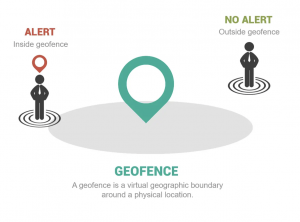What is geofencing?
Geofencing is a location-based service in which an app or other software uses GPS, RFID, Wi-Fi or cellular data to trigger a pre-programmed action when a mobile device or RFID tag enters or exits a virtual boundary set up around a geographical location, known as a geofence.
an app or other software uses GPS, RFID, Wi-Fi or cellular data to trigger a pre-programmed action when a mobile device or RFID tag enters or exits a virtual boundary set up around a geographical location, known as a geofence.
Depending on how a geofence is configured it can prompt mobile push notifications, trigger text messages or alerts, send targeted advertisements on social media, allow tracking on vehicle fleets, disable certain technology or deliver location-based marketing data.
Some geofences are set up to monitor activity in secure areas, allowing management to see alerts when anyone enters or leaves a specific area. Businesses can also use geofencing to monitor employees in the field, automate time cards and keep track of company property.
How geofencing works
To make use of geofencing, an administrator or developer must first establish a virtual boundary around a specified location in GPS- or RFID-enabled software. This can be as simple as a circle drawn 100 feet around a location on Google Maps, as specified using APIs when developing a mobile app. This virtual geofence will then trigger a response when an authorized device enters or exits that area, as specified by the administrator or developer.
as specified using APIs when developing a mobile app. This virtual geofence will then trigger a response when an authorized device enters or exits that area, as specified by the administrator or developer.
A geofence is most commonly defined within the code of a mobile application, especially since users need to opt-in to location services for the geofence to work. If you go to a concert venue, they might have an app you can download that will deliver information about the event. Or, a retailer might draw a geofence around its outlets to trigger mobile alerts for customers who have downloaded the retailer’s mobile app. In these cases, a geofence that is managed by the  retailer is programmed into the app, and users can opt to decline location access for the app.
retailer is programmed into the app, and users can opt to decline location access for the app.
A geofence can also be set up by end-users using geofencing capabilities in their mobile apps. These apps, such as iOS Reminders, allow you to choose an address or location where you want to trigger a specific alert or push notification. This is called an “if this, then that” command, where an app is programmed to trigger an action based off another action. For example, “If I’m five feet from my front door, turn on my lights.” Or you might ask a reminder app to send you an alert once you reach a specific location.
Geofencing ‘LIFT’ <or Addressable Advertising>
One of the biggest questions clients ask us is: “But how do I know IF the customers who walk into my business came-in because of the Ad”?
With Geo-Conversion Lift, advertisers gain understanding and insights about how their mobile ad campaigns drive incremental foot traffic into physical locations.
Advertisers of all types and sizes are increasingly demanding attribution models that show how ads served on mobile devices influence physical visits to stores and other locations. This data is vitally important to advertisers as more than 92 percent of shopping in the U.S. is still done in brick and mortar stores.
Geo-Conversion Lift is a new dashboard in the Reporting and Analytics center that enables advertisers to measure the increase in foot traffic to a desired location by users who have been served ads in the campaigns. This is measured against a baseline of users who have not been served ads. Key metrics clients can access via Geo-Conversion Lift include:
-
- Campaign Conversion Rate: The percentage of users who were detected in a target zone, were then served an ad, and then were detected in a conversion zone for the same campaign.
-
- Natural Conversion Rate: The percentage of users that have been detected in a target zone, not served an ad, and then detected in a conversion zone for the same campaign.
-
- Geo-Conversion Lift: Percentage difference in Campaign Conversion Rate vs. Natural Conversion Rate.
-
- New User Campaign Conversion Lift: The campaign conversion lift with repeat converters excluded.
-
- Natural Days to Convert: The average number of days it takes users who have not been served an ad to go from a target zone to the Conversion Zone.
- Campaign Days to Convert: The average number of days it takes users who were served an ad to go from a target zone to the conversion zone.
 Yes (this does sound like ‘big brother’ is watching), but only in a good-way so we can help clients know that their hard-earned marketing dollars really ARE ‘working’.
Yes (this does sound like ‘big brother’ is watching), but only in a good-way so we can help clients know that their hard-earned marketing dollars really ARE ‘working’.
If you’d like to find out more about GeoFencing, give us a buzz and we’ll be more than happy to give you a ‘PEEK behind the curtain’ on how Geo-Fencing can drive traffic into your location(s).

 317-289-4965
317-289-4965